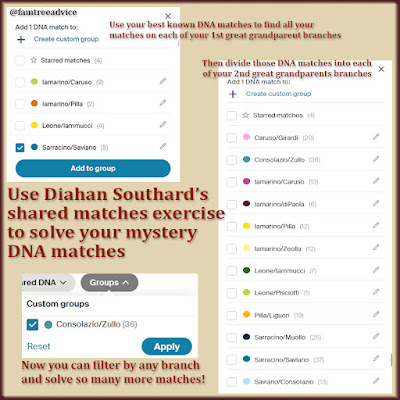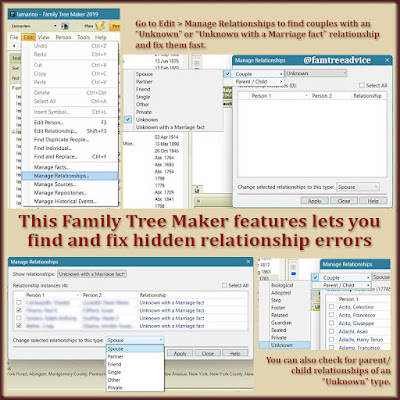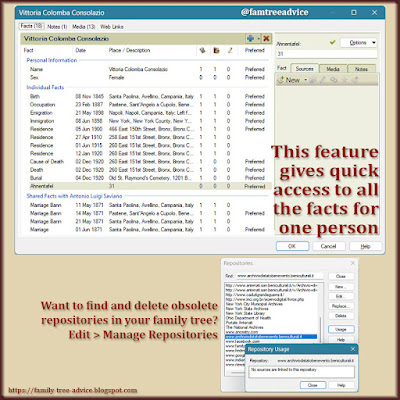Last week's article on sorting your DNA matches by grandparent branch was a big hit. Thank you for reading it! Since that DNA exercise was so popular, I've got another one for you. This is especially helpful for those of you whose parents have not DNA tested.
This color-coding exercise comes from a RootsTech presentation by Diahan Southard. It's called, "Shared Matches—The only DNA tool you will ever need."
Choose a Goal No Further Back than a 3rd Great Grandparent
My goal for this exercise is to find descendants of my unknown 3rd great grandmother. All I know is she married Antonio Muollo in the tiny hamlet of Pastene in Italy. To do this, I'll choose the closest match I know who descends from each of my 4 pairs of 1st great grandparents. These should be people who you've already fit into your family tree. Southard calls these cousins your Best Known Matches, or BKMs.
For each BKM, click to view them and find the list of your shared matches. (The location of this list depends on your DNA website.) These are people who match both you and the BKM. Create a color-code on your DNA website for each of your 1st great grandparent pairs. Give the right color to all the shared matches of each BKM. Give it to your BKM from that branch, too.
 |
| Divide your DNA matches with this color-coding system and watch all the pieces fall into place. |
You can go a step further and give that color to the shared matches of everyone in your BKM's shared match list.
Without using my parents or reusing any BKMs, here are my closest tested cousins for each branch. They're strong matches with longest segments of shared DNA between 35 and 86 cMs.
BKMs by 1st great grandparents branch:
- Iamarino/Caruso—June 1C1R, 441 cM match, longest segment 51 cM
- Iamarino/Pilla—Jessica 3C1R, 168 cM match, longest segment 65 cM
- Leone/Iammucci—Nicky 1C, 793 cM match, longest segment 86 cM
- Sarracino/Saviano—Christine 2C, 308 cM match, longest segment 35 cM
If that list is confusing, it's because my father's parents were both named Iamarino. They were 3rd cousins.
Use Color-Coding to Filter Your Matches
Next, I'll go back to my main match page and filter my list by only my Sarracino/Saviano branch. The goal is to separate them by my 2nd great grandparent couples. I'll use another color to divide the Sarracino-only matches into a 2nd great grandparent group called Sarracino/Muollo. And I'll divide the Saviano-only matches into a 2nd great grandparent group called Saviano/Consolazio. It's the Sarracino/Muollo group that can help me break through my Muollo brick wall.
Here are the BKMs I chose for my 2nd great grandparent branches:
- Sarracino/Muollo—Mary, 191 cM match, longest segment 51 cM
- Saviano/Consolazio—Teresa, 2C1R, 157 cM match, longest segment 35 cM
- Iamarino/Zeolla—another Teresa, 125 cM match, longest segment 65 cM
- Pilla/Liguori—Nicole, 59 cM match, longest segment 25 cM
- Iamarino/diPaola—Keith, 2C, 232 cM match, longest segment 51 cM
- Caruso/Girardi—Daniel, 2C, 229 cM match, longest segment 42 cM
- Leone/Pisciotti—Anne, 3C, 97 cM match, longest segment 71 cM
- Iammucci/Bozza—none! There's only my mother and 1C Nicky.
You May Find Some Surprises
Diahan Southard said this exercise can point out the endogamy in your family tree. Endogamy is when generations of families keep intermarrying. That leaves you with multiple relationships to people. And it's very common in the small, somewhat isolated hill towns that were home to all my ancestors.
I see endogamy right away because my only 1C who's tested, my maternal 1st cousin, is somehow a match to my father. He's a very distant relation to my Dad. They share only 11 cMs in one segment. They each have ancestors from bordering towns, so there are lots of ways they may connect. But I'll probably never find the answer.
If you don't have endogamy, this process should work extremely well for you. You'll wind up with a long list of matches who must belong to a particular branch of your family tree. They've probably been mystery matches because they have no tree or no familiar names.
As a shortcut, I took Southard's advice and looked at Ancestry's ThruLines® for Muollo branch descendants. There's only one, aside from my 1C and my mom. She's my 3C1R, and she looks remarkably like me. It's possibly she has some Muollo in her ancestry, but she seems to be only on the Sarracino side. If there is a Muollo descendant in my matches, they don't have a public family tree. Still, I will circle back and examine my shared matches with my lookalike 3C1R.
With the Muollo branch at an impasse, I turned my attention to my Consolazio ancestors. My 2nd great grandmother was a Consolazio from the town of Santa Paolina. Many people from that town intermarried with people in the neighboring town of Tufo. And my Tufo vital record collection needs a lot more research.
I chose as my BKM Lynda, my 3C3R, 30 cM match, with a longest segment of 19 cM. I know exactly where she belongs on the Consolazio branch. I marked her and our shared matches with the color for my Consolazio/Zullo branch.
Harvest Your Mystery Matches
Looking at these matches, I moved onto the next step, which is Southard's mantra, "Do genealogy!" I'll choose a shared match with a decent family tree and expand it until it reaches a branch of my tree.
I was digging into one match with a Consolazio family in his tree, but they were from the wrong town. I researched them anyway, and they did, in fact, have roots in my Consolazio town of Santa Paolina. That's a good lesson right there. Don't count someone out because their closer ancestors come from a place you don't know. Dig deeper!
 |
| Expert Diahan Southard offers this incredible method for finding exactly the DNA matches you need. I can't praise this method highly enough. |
When I did the genealogy, this match whose close family was from another town turned out to be my 3C2R. Our longest shared DNA segment measured 20 cM, which is now very logical.
Our common ancestors are my 4th great grandparents, Gaetano Consolazio and Colomba Ricciardelli. Our shared roots go very deep in Santa Paolina. I color-coded all our shared matches as Consolazio/Zullo.
In the past I marked one of our shared matches as "Consolazio NOT from Santa Paolina." Now I knew I needed to dig into her family tree to bring her roots back to my town. And I did it! I found our connection, which was a mystery before today. She's my 4C1R, and we share the same ancestors—Gaetano Consolazio and Colomba Ricciardelli.
I'd marked another shared match as "lots of Santa Paolina names." Today's exercise brought him to my attention again. Almost instantly, I saw a way into his tree. His grandfather is already in my family tree, but there isn't a cousin connection. When I researched his grandmother, I found our connection. Now this mystery match is my 5C1R.
This is really working! Diahan Southard hit the nail on the head in her presentation. She said, "Stop looking at shared last names, and start looking at shared matches. Then, do genealogy."
This method can solve a ton of your mystery DNA matches. Give it a try!




